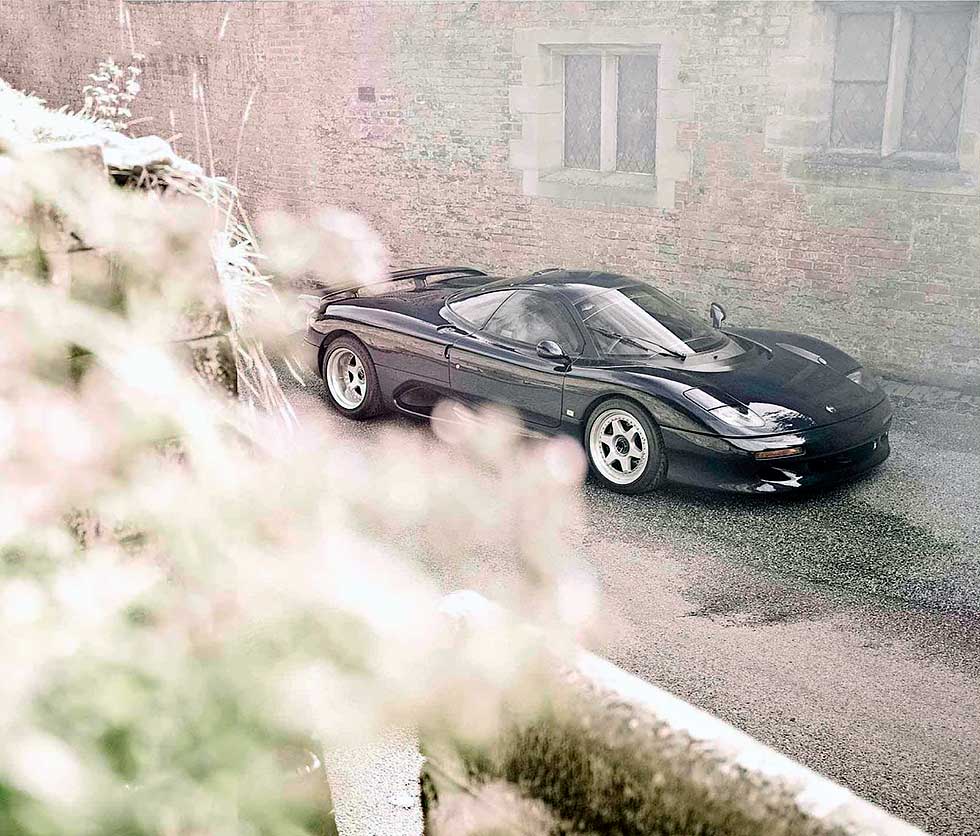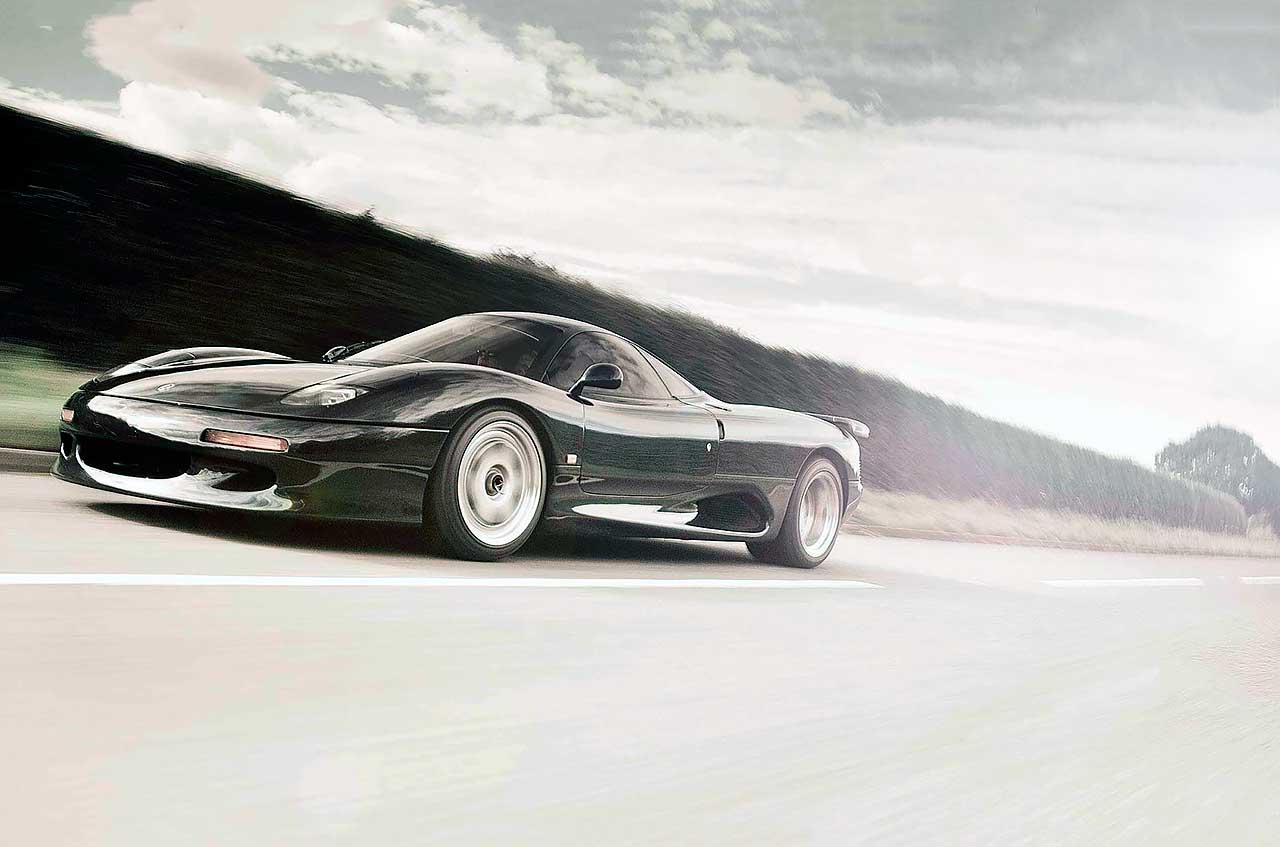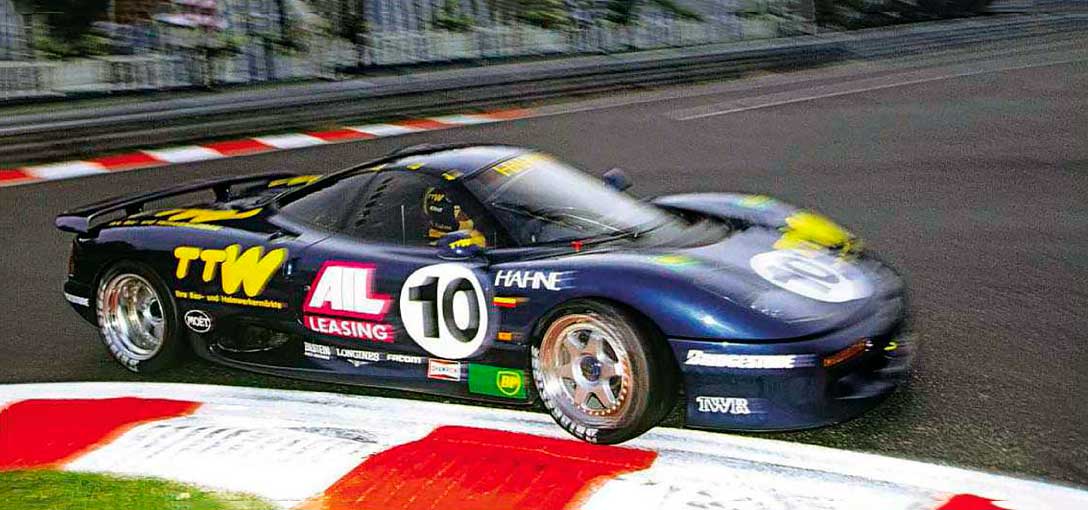
Can 21st century technology tame the wildest cat for the road? Tamed by modern tech? Finishing school. The original 1990-1992 JaguarSport XJR-15 was uncompromising, unapologetic – and pretty much unsuitable for anything other than a racetrack. Can 21st century technology tame the wildest Cat ever for use on the road’? Words Richard Heseltine. Photography Mitch Pashavair.
Is impression of Munch’s The Scream is uncannily convincing. In fairness, we have been making a bit of a racket, the incongruity of a sleepy hamlet and a rowdy supercar becoming increasingly obvious. Aggrieved of Staffordshire can take no more of our endless panning shots, so he strides into the middle of the road to make his point: something about the recklessness of us driving a car at walking pace near cottages. Or something. In truth, his rant is lost over the sound of an angry race-bred V12 being blipped out of fear that it might stall. Again. Sorry, what was that you were saying?

This vignette illustrates all that is great and galling about the JaguarSport XJR-15. It is the polar opposite of latter-day supercars, in that there are no ‘get out of jail free’ driver aids here and only token concessions to civility. In essence, it’s a Group C car with all the benefits and evils that might confer. It’s also truly, really beautiful, which only adds to its near-mythical status. Few XJR-15s are ever seen publicly, and fewer still get driven. This example has covered barely 400 miles since 1991. In many ways it’s one of the most coveted Jaguars, yet it’s also one of the most misunderstood.
But then, strictly speaking, it’s a cuckoo in the nest; an interloper in marque lore. When news first leaked of the XJR-15’s existence in 1990 it caught Jaguar’s management off guard. The car’s instigator, Tom Walkinshaw, had returned the name to prominence trackside, first in Touring Cars and then in the World Endurance Championship. He had also been tasked with turning the XJ220 concept into a fully functioning production car. Predictably, Jaguar’s management wasn’t too thrilled at the prospect of its motor sport partner building a direct competitor, and hauled Walkinshaw in for a chat. The net result was that the XJR-15 never did take on the supercar elite. Instead, it became a racing car with a small run being diverted into the 1991-only Intercontinental Challenge one-make series.
‘It came about after Tom and I visited the 1988 British Motor Show and saw the Jaguar XJ220 concept,’ designer Peter Stevens recalls. ‘Tom wasn’t impressed and asked me if I could do better. By February of the following year we had the full-scale clay finished, and then Tom gave us the tub from an XJR-9. It was the car in which Win Percy had his massive accident at Le Mans in 1988. Tom told us to use what we wanted. Of course, there were changes, not least because using the whole thing would’ve compromised on the XJR-15 having proper doors, but the basic structure remained the same. The entire project took little more than a year, but by the time it was done Jaguar had given Tom the job of putting the XJ220 into production. This caused a few headaches, and we did mull over offering customers the option of an XJ220 with our front and rear bodywork. That got as far as the model stage.’
Of course, a lack of Type Approval was no barrier to those punters who had laid down a cool £500,000 for the privilege of owning an XJR-15. It complied with Construction and Use regulations, so it’s no great surprise that some of the 53 cars made were adapted for road use. Thing is, anyone who’s ever driven one on the road will tell you it isn’t always a pleasant experience: the car is raw, uncompromising and at times unsettling. This particular example, however, has benefited from some thorough Don Law Racing revisions – and it’s great.
Back in the early ’90s it seemed as though a week didn’t go by without another vowel-laden supercar being launched amid much hoopla. However, there was a pecking order, with Maranello and Sant’ Agata holding firm, but the XJR-15 had them licked on styling alone. By definition supercars are all about excitement, bombast and spectacle, but here the outline is free-flowing and devoid of tinsel. It isn’t cliched or anachronistic, just sexy as hell.
There really are no bum notes stylistically. The nose is home to fixed driving lights and pop-ups which blend fluently into the cab- forward bubble top, the tapering wedge rising from the A-pillar to the neatly cropped tail. The profusion of louvres and that vast spoiler atop the rear deck area merely add a little drama to proceedings. It’s breathtaking. Yet this is but a mere carbonfibre veneer for what is essentially an XJR-9 sports-prototype (the road car’s name was originally to have been TWR-9R), which swept the podium positions at Le Mans in 1988.
Nowhere is this competition breeding more evident than on stepping, stooping and generally flailing into the cabin. There is no graceful means of entry; the low roofline and ultra-wide sill make sure of that. The crack of a door aperture doesn’t help, either. It’s all too difficult not to stand on the driver’s seat, clad in Connolly’s finest hides, as you try to thread your way in – but this does rather go with the territory.

Once inside, the cockpit is somewhat claustrophobic and an alien realm for anyone easily baffled by racer switchgear. The view ahead is of the panoramic kind, the humongous double-curvature windscreen being partially framed by a large parallelogram wiper. Headroom is adequate because you sit so low, the rear canopy being made of high- temperature acrylic with a smoked grey tint. The central roof panel was hitherto bonded to the main structure and roll cage, but here it’s removable to aid access to plugs and suchlike.
All around you is further evidence of the XJR-15’s competition ancestry. Inset in the Kevlar dash is a bank of gauges dominated by the 220mph speedo and a revcounter that ends at 7000rpm. There is no red line: the six-litre 60° V12 develops 450bhp at 6250rpm, so it was considered unnecessary. Also within the main binnacle are four supplementary instruments, but the budget clearly didn’t stretch to a fuel gauge. Much like an old Fiat 500, there’s merely a light to inform you that you’re just about to run out of petrol – or already have. To your right is the emergency kill switch and four competition-style toggle switches which must be activated in sequence to start the engine.
Racing harnesses are always a chore, but once buckled up the sense of occasion is tangible: turn the red master switch clockwise and then flick the ignition, fuel-injection and twin fuel-pump toggles before taking a deep, cleansing breath. It’s now time to nail the starter. What follows is a distant whir. It’s hard to pinpoint where precisely this is coming from, only that fuel and air are meeting as a dozen pistons chime into life. The noise – the bellow – on firing up is otherworldly. When writing about supercars, it’s all too easy for prose to take a turn for the purple, but in this instance loud really means LOUD!
If this seismic blast isn’t intimidating enough, trying to manoeuvre the car is freighted with anxiety. Visibility is better than in most cars of this ilk, but that in itself isn’t saying much. The Jaguar also has the turning circle of an ocean liner yet, most of all, it has a triple-plate clutch which plaits hamstrings and snaps tendons: for this reason, the XJR-15 isn’t a car for posing in. Trundling down the King’s Road really isn’t its thing. The five- speed FF transmission (TWR six-speed crash ‘box on the racers) requires respect. The right- hand lever has a longish throw and, despite the synchro, it’s advisable to double declutch.
At low revs the V12 powerhouse doesn’t sound particularly sonorous, the madrigal of percussive squeaks through the structure doing their best to drown it out. In true Group C style, the engine is solid-mounted so there are bound to be some strange harmonics. In time, these sounds become familiar to the point that they almost fade away, only to become noticeable if they change in pitch or rhythm. Past 3000rpm the engine note becomes increasingly gnarly and strung-out.
Based on a standard block, the V12’s bottom end was built to Group C spec, while the top end came from TWR’s XJR-S programme. Packing 420lb ft of torque at 4200rpm it’s perfectly tractable, so you’re never left hunting for an appropriate gear. The upgraded Motec engine-management system makes all the difference for smoother running, as does the different cam.
Engine bay heat build-up is historically a major issue, too, but here there’s a new rad designed to fit into the original mounts and carbon-surround panels. There’s also a double ceramic-coated exhaust, bigger engine bay fans, more effective ducting and proper sealing around various areas of the carbon tub. ‘TWR could hide behind the fact that it was not a homologated road car,’ Don Law says. ‘It didn’t want to spend any money beyond what was needed to get the car on track for a short race.
That the XJR-15 is fast is a given, but the manner in which it accelerates is pulverisingly physical. According to TWR’s own figures the 0-60mph dash takes around 3.7 seconds, and that seems entirely plausible. Press on, and the engine note becomes increasingly intrusive. The V12 bellow is intoxicating but over long spells it assails your ears. No matter; TWR considerately provided ‘cans’ to protect them.
And of all the many subtle Don Law Racing tweaks here, by far the most welcome over the long haul is the addition of a much – much – more effective air-conditioning set-up than the standard item. Without it, you will lose half your bodyweight in perspiration, as the cabin gets very toasty very quickly. Also gone is the giddying aroma of petrol which anyone who has ever driven an XJR-15 over a reasonable distance will remember. The standard FT3 race fuel cell has made way for a Teflon-lined cell as per the XJ220 and McLaren F1.
Riding on massive Michelins (9.5J x 17in front, 13J x 17in rear), there is a slight tendency towards tramlining on uneven blacktop, but the ride quality is much better than you might imagine. The unassisted steering, too, is heavy at slow speeds but meters out instant feedback the faster you go. The flat-bottomed 13in steering wheel doesn’t writhe in your hands as in many similar cars, and you always feel plugged into the action, but it’s highly unlikely you would ever get so much as a chirrup out of the fat rear rubber without venturing trackside.
Meanwhile, the massive AP ventilated disc brake set-up is also hugely powerful, which heightens confidence. Law is keeping mum about some of the suspension mods, other than to say: ‘We’ve done a lot of work on alternative springs and different damper valving. We’ve also put a lot of effort into improving suspension geometry. I think these changes, plus a digital engine-management system and the cam swap, are key to making the car better and much more usable.’
And it is, too – but even with these thoughtfully integrated mods, the XJR-15 remains a blunt instrument. Whereas the XJ220 is comfortable, relatively easy to drive at high speed and docile when you want it to be, this is none of those things. It’s about as hardcore as supercars get. In many ways it’s akin to the XKSS, the road-going version of the D-type. The concept’s merely moved on, the key difference being that there is no duality of character here. You simply emerge from the XJR-15 slightly shell-shocked, going 19 to the dozen at anyone who will listen before slowly floating back down to earth. These changes haven’t altered its character one iota – they’ve simply made it the car you always hoped it would be.
THANKS TO Don Law Racing (www.donlawracing.com) and Rod Leach.
Tech and photos
TECHNICAL DATA FILE SPECIFICATIONS 1990 Jaguar Sport XJR-15
ENGINE 5993cc 60° V12 with twin chain-driven cams, Motec engine management
MAX POWER 450bhp @ 6250rpm / DIN
MAX TORQUE 420lb ft @ 4200rpm / DIN
TRANSMISSION Five-speed manual
STEERING Rack and pinion
SUSPENSION Front: wishbones, actuating pushrods to spring/damper units. Rear: alloy uprights, coil springs and dampers mounted within wheels
BRAKES Ventilated discs all-round
WEIGHT 1050kg
PERFORMANCE Top speed 185mph
Below and right Subtle Don Law Racing tweaks have rendered the ultimate Jaguar supercar more roadable without altering its character one bit; they have simply made it the car you – and we – always hoped it would be.
‘The XJR-15’s outline is free-flowing and devoid of tinsel. It isn’t cliched or anachronistic, just sexy as hell’
‘You emerge from the XJR-15’s cabin slightly shell-shocked, going 19 to the dozen at anyone who will listen’
‘Even with these mods, the XJR-15 remains a blunt instrument. It’s about as hardcore as supercars get’
Racing with the wild Cats
JaguarSport’s XJR-15 one-make series was inspired – if ultimately chaotic… LAT Photographic.
Tom Walkinshaw always was a canny operator. With Jaguar’s management effectively stamping on the XJR-15 as a road car, the Scot was forced to change tack. Enter 1991’s JaguarSport Intercontinental Challenge which was – and remains – the ultimate one- make championship. The concept was simple: 16 identical cars would vie for honours in support of the Monaco, Belgian and British GPs, each having been pre-sold. Professional racers would be employed to pedal them, although privateers were free to drive themselves – deep enough pockets allowing. And just as night follows day, the result was carnage.
That said, the opening practice session for April’s Monaco race passed with little incident, save for Tiff Needell being nurfed at Ste Devote by IMSA star Davy Jones. Tiff has little fondness for the XJR-15: Tt was the worst- handling car I ever raced! Heavy, no aero, high centre of gravity and almost grip-less!’ Sports car ace Armin Hahne was particularly keen to gain an unfair advantage, the Monaco resident having sweet-talked a policeman into allowing him a few hot laps of the closed-off track in his BMW M5 before dawn. The German starred in the drizzly first session but was still some way off Derek Warwick, who was fastest throughout. A day later, ‘Del Boy’ ignored the pouring rain and planted his car on pole.

On race day, Warwick and Hahne headed the pack behind the XJ-S pace car driven by Walkinshaw. As the flag dropped on the rolling start, Warwick momentarily lost out but he muscled his way past Hahne at Ste Devote on the opening tour and led to the flag. His bid was helped somewhat by John Nielsen, the Dane having demolished his car on the second lap. All down the order there were spins and dramas, each driver emerging wide-eyed and with a story to tell, with David Brabham and Jones completing the podium positions.
Then came the Silverstone race on 14 July, in which 11 cars departed Northamptonshire with body damage. Walkinshaw once again led the field for the pace lap, except that the drivers headed by pole man Warwick evidently had short attention spans: the front two rows blasted past the XJ-S, with Brabham taking the lead, only to run wide at Copse which allowed Cor Euser through as Warwick gave chase. The next 19 laps saw the lead change umpteen times amid lurid spins and the sort of driving that would make a BTCC ace blush. It became so physical that Nielsen decided to pit and sit out the race. Amid the chaos, the vastly underrated Juan Manuel Fangio II came home first, from Bob Wollek and plucky Brit Ian Flux; the winner received a new XJ-S road car.
After the mother of all rollickings from Walkinshaw, the drivers then descended on Spa in late August for the final round, where the winner would receive a cheque for $lm. In a bid to deter the sort of driving that had blighted the previous race, and to bat away collusion among drivers, Walkinshaw kept the race distance to himself. The chequered flag would descend when he felt like it.
Having racked up a £47,000 repair bill for his efforts at Silverstone, pole-sitter Euser was particularly keen to win this back and more for his car’s owner. The Dutchman led at the off, fellow front-row starter Brabham surviving an almighty slide exiting Eau Rouge just moments into the race. Warwick and John Watson were among the star names affected by accidents, with Hahne emerging victorious after 11 laps from Euser with saloon car ace Win Percy third.
The likable West Countryman recalls: ‘The V12 was fantastic but there was no downforce. The XJR-15 was very unstable at high speed and you couldn’t relax. It was like driving on ice. I was running fourth at Spa and right up under Derek Warwick on the fast run back to the Bus Stop when I suddenly realised I could see more of the back of his car than on the slower comers: I was taking the air from the back of his car so he just rotated in front of me and completely wrecked it all the way down the Armco. I never did find out who owned “my” car; there wasn’t a scratch on it, I might add!’
Walkinshaw made his cash back and more, and two years later announced a new series. Fast Masters would pit big-name drivers aged over 50 in identical XJ220s. On quarter-mile oval tracks. What’s the worst that could happen?
“The concept was simple: 16 identical ears would vie for honours. And just as night follows day, the result was carnage”





